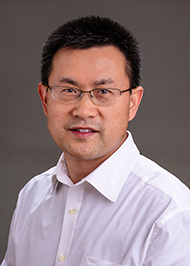Shaoping Hou, Ph.D.
Associate ProfessorInterdisciplinary Neuroscience Faculty
Department of Pathology & Anatomical Sciences
Department of Physical Medicine and Rehabilitation
School of Medicine
Office Location: 302 DCRC
Office Phone: 573-882-4197
shou@health.missouri.edu
Research Interests
- Autonomic dysfunction following spinal cord injury
- Micturition reflexes and cardiovascular disorders
- Neuroendocrine mechanisms of hemodynamics
- Axon regeneration, Cell transplantation, Cell reprogramming
- Exercise and rehabilitation
- Fibrotic scarring in the CNS
Research Description
Traumatic spinal cord injury (SCI) results not only in sensorimotor deficits but also in autonomic dysfunction. The disruption of supraspinal autonomic pathways renders abnormalities in multiple organ systems including compromised urinary, cardiovascular, respiratory, gastrointestinal, thermoregulatory, and sexual activities. Despite varied symptoms based upon the level and severity of the injury, the loss of descending regulation and subsequent maladaptation in the lower spinal cord underlie disordered autonomic activity after SCI. Over recent decades, autonomic dysfunction after SCI has drawn more investigations as researchers and clinicians began to pronounce their clinical priorities. Our research emphasizes both lower urinary tract and cardiovascular dysfunctions after SCI. We employ multidisciplinary approaches, including neuroanatomical, physiological, as well as cellular and molecular techniques, to elucidate supraspinal and intraspinal neuronal machinery of micturition and hemodynamics in the intact and SCI rat models. Recent findings revealed that spinal endogenous dopaminergic mechanisms regulate the recovered spontaneous bladder reflexes after SCI. In the central nervous system, injured axonal projections are particularly refractory to growth due to neural intrinsic and extrinsic factors. We are exploring effective strategies to increase growth capability and reduce inhibitory aspects for axon regeneration following SCI. Utilizing a myriad of therapeutic approaches, such as neural progenitor cell transplantation, passive exercise, cell reprogramming, and pharmacological interventions, our team further attempts to rebuild neuronal pathways for autonomic functional recovery.
Professional Background
- Research associate, Assistant professor, Associate professor, Spinal Cord Research Center, Department of Neurobiology & Anatomy, Drexel University College of Medicine
- Postdoctoral scholar, Center for Neural Repair, Department of Neuroscience, University of California, San Diego
- Postdoctoral fellow, Spinal Cord and Brain Injury Research Center (SCoBIRC), University of Kentucky
- PhD in Neuroscience, Capital Medical University, China
Selected Publications
- Fernandes S, Oatman E, Weinberger J, Dixon A, Osei-Owusu P, Hou S. The susceptibility of cardiac arrhythmias after spinal cord crush injury in rats. Experimental Neurology Aug 8; 357:114200 (2022). PMID: 35952765
- Hou S, DeFinis JH, Daugherty SL, Tang C, Weinberger J, de Groat WC. Deciphering spinal endogenous dopaminergic mechanisms that modulate micturition reflexes in rats with spinal cord injury. eNeuro 8(4): 0157-21 (2021). PMID: 34244339
- DeFinis JH, Hou S. Dual-pseudorabies viral tracing for spinal tyrosine hydroxylase interneurons involved in segmental micturition reflex circuitry in spinal cord injured rats. Neurotrauma Report. 2(1):660-668 (2021). PMID: 35018366
- Qiao Y, Brodnik ZD, Zhao S, Trueblood CT, Li Z, Tom VJ, España RA, Hou S. Spinal dopaminergic mechanisms regulating the micturition reflex in male rats with complete spinal cord injury. Journal of Neurotrauma 38(6):803-817 (2021). PMID: 33297828
- Zhao S, DeFinis JH, Hou S. Alterations of dopamine-related transcripts in A11 diencephalospinal pathways after spinal cord injury. Neural Plasticity. (2021). PMID: 33510781
- Hou S, Saltos TM, Mironets E, Trueblood CT, Connors TM, Tom VJ. Grafting embryonic raphe neurons reestablishes serotonergic regulation of sympathetic activity to improve cardiovascular function after spinal cord injury. The Journal of Neuroscience 40(6):1248-1264 (2020). PMID: 31896670
- Trueblood CT, Iredia IW, Collyer ES, Tom VJ, Hou S. Development of cardiovascular dysfunction in a rat spinal cord crush model and responses to serotonergic interventions. Journal of Neurotrauma 36(9):1478-1486 (2019). PMID: 30362884
- Hou S., Carson D.M., Wu D., Klaw M.C., Houlé J.D., Tom V.J. Dopamine is produced in the rat spinal cord and regulates micturition reflex after spinal cord injury. Experimental Neurology 285 (2016) 136-146. PMID: 26655672




